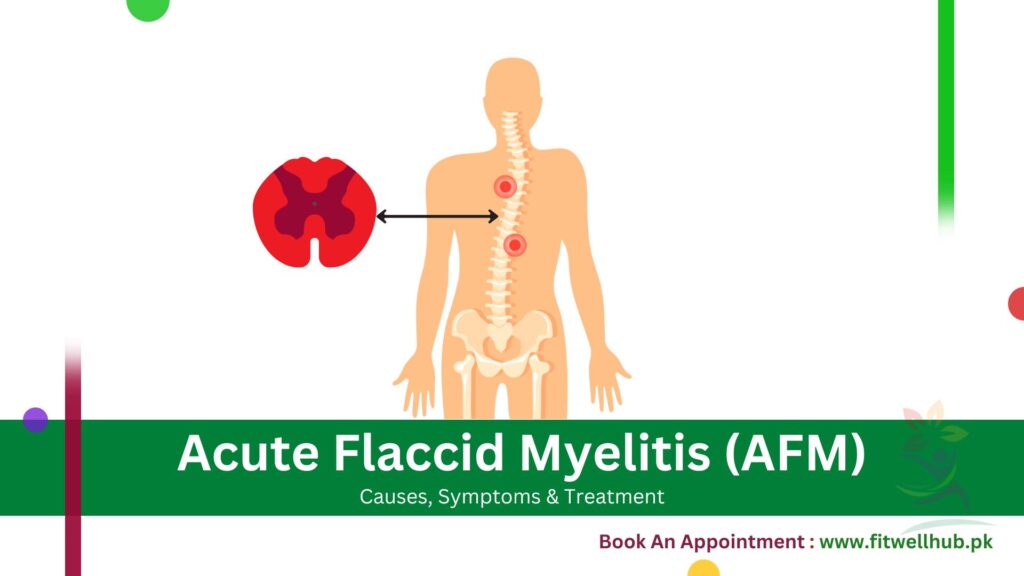AFM (Acute Flaccid Myelitis) is an uncommon but severe neurologic condition affecting the nervous system. It causes damage to the spinal cord that leads to permanent paralysis occasionally and muscle weakness.
Quick Links
ToggleAFM disorder is difficult to understand but it causes a significant effect on the duration and quality of life of an individual.
Symptoms & Diagnosis
Symptoms
The basic symptoms of AFM are instant paralysis and muscle weakness in one or both arms or legs. Other symptoms of this neurological disorder that patients might experience are:
- Facial bending
- Difficulty in speaking or swallowing
- Changes in senses
- breathing problems
- Pain in affected muscles
Diagnosis
AFM is difficult to diagnose because most of its symptoms are the same as for other neurologic cases. Therefore healthcare professionals use physical examination, and medical history and suggest different diagnostic tests. Some of the tests are:
- MRI (Magnetic Resonance Imaging) test is helpful to examine the brain and spinal cord.
- CFA (Cerebrospinal Fluid Analysis) is used to check the symptoms of inflammation.
- Electromyography and NCS (Nerve Conduction Studies) test is used to assess nerve and muscle function
FitwellHub offers expert consultations and access to complete diagnostic services to ensure that your child has an accurate diagnosis and personalized care. Visit FitwellHub Labs for more information.
When to See a Doctor
If you experience sudden paralysis in the legs or arms, muscle weakness, difficulty swallowing or speaking, or difficulty breathing, you must visit a doctor. These symptoms may be indications of Acute Flaccid Myelitis (AFM), regular check-ups, and immediate consultations are important. If you need consultation for your symptoms, Fitwell Hub offers expert medical consultations.
Treatment Options for Acute Flaccid Myelitis
The treatment options to cure AFM depend upon the severity of the disease and the patient’s response toward different medical therapies. Some of the other treatment options are given below:
- Supportive treatment such as occupational therapy, respiratory assistance, and physical therapy.
- To potentially speed up recovery and help in decreasing inflammation Immunomodulatory therapies are adopted such as steroids or intravenous immunoglobulin (IVIG).
- Antiviral treatments are helpful to treat basic viral infections in some situations.
- In severe conditions, surgical treatments can be used such as spinal cord decompression.
Prognosis and Life Expectancy of AFM
The life expectancy of AFM depends upon different factors such as the severity of the condition, the person’s age, and the extent and speed of recovery from the disease.
AFM-affected individuals may experience prolonged prognosis or many will have residual paralysis or weaknesses.
Some information about life expectancy and prognosis of AFM is:
- Muscle function may improve fully or partially in about 50-60% of individuals with AFM and most of their recovery occurs within the first six months.
- However, a significant number about 40-50% of individuals will experience long-term or chronic neurological disorders such as respiratory impairment or paralysis.
- The death rate is relatively low, about 5-10% of individuals with AFM die from its complications and conditions.
- Life expectancy decreases for individuals particularly those with severe or developing neurological and respiratory impairment.
Risk Factors Affecting Recovery From Acute Flaccid Paralysis
Different risk factors that may influence the long-term prognosis and recovery for individuals are:
- Age: Compared to older adults, younger patients, especially children, tend towards higher rates and better recovery results.
- The severity of Symptoms: Individuals who have more severe basic symptoms of acute flaccid paralysis such as respiratory discomfort or considerable paralysis generally experience poorer prognosis.
- Timing of Treatment: The chances of better results increase with early diagnosis and the start of an effective treatment approach.
- Underlying Causes: The particular virus or another trigger that causes the development of AFM can affect the disease and treatment output.
- Access to Rehabilitation: A complete rehabilitation technique such as respiratory support, occupational therapy, and physical examination can be beneficial in retaining previous body functionality and improving life quality.
Acute Flaccid Myelitis in Adults: Prevalence and Implications
AFM is most commonly occurs in children rather than adults but can also affect adults.
Some of the important points of AFM in adults are:
- About 20-30 % of cases of AFM are also present in adults but still, most of the cases are seen in children.
- In adults, the clinical presentation and symptoms of AFM are the same as found in children such as paralysis and muscle weakness being the basic concerns.
- For adults, the long-term results and the prognosis with acute flaccid paralysis may change, experiencing partial or full recovery, but others may go through permanent neurological loss.
- The challenges for adults having AFM are unique like the need for caretaking responsibilities and balance rehabilitation. It can also affect their financial stability and employment.
The Role of the CDC in Monitoring and Researching AFM
For ongoing research and monitoring of AFM, the CDC (The Centers for Disease Control and Prevention) plays an important role. In addressing AFM, the significant techniques of the CDC are:
1- Surveillance & Reporting
To track the trends for this condition and recognize epidemiology better, the CDC collaborates with state health departments and healthcare providers to investigate and track the cases reported for AFM.
2- Research & Investigation
The CDC carries out research-based studies to determine the primary causes of AFM. These studies also explore the possible risk factors and create more treatment strategies and effective diagnostics.
3- Guidance & Recommendations
The CDC gives recommendations and clinical guidance to healthcare providers so that they can recognize, diagnose, and manage AFM cases.
4- Public Education & Awareness
The CDC provides awareness and educates people about the symptoms and the need for urgent medical attention.
Frequently Ask Questions (FAQ’s)
AFM can be caused by viral infections such as enterovirus which can cause fever and respiratory illness.
AFM usually starts with the basic symptoms such as instant paralysis and muscle weakness in one or both arms or legs.
Recovery is different among individuals because some people fully recover and some pose persistent paralysis and muscle weakness and require long-term therapies for recovery.
The survival rate for acute flaccid myelitis is high but may lead to prominent disability. About less than 10% of people are fully recovered from AFM and others will recover from AFM over time through long-term therapies.
AFM can be diagnosed by physical examination and different tests such as MRI to examine spinal cord grey lesions, Electromyography, and NCS(Nerve Conduction Studies) test is used to assess nerve and muscle function.











